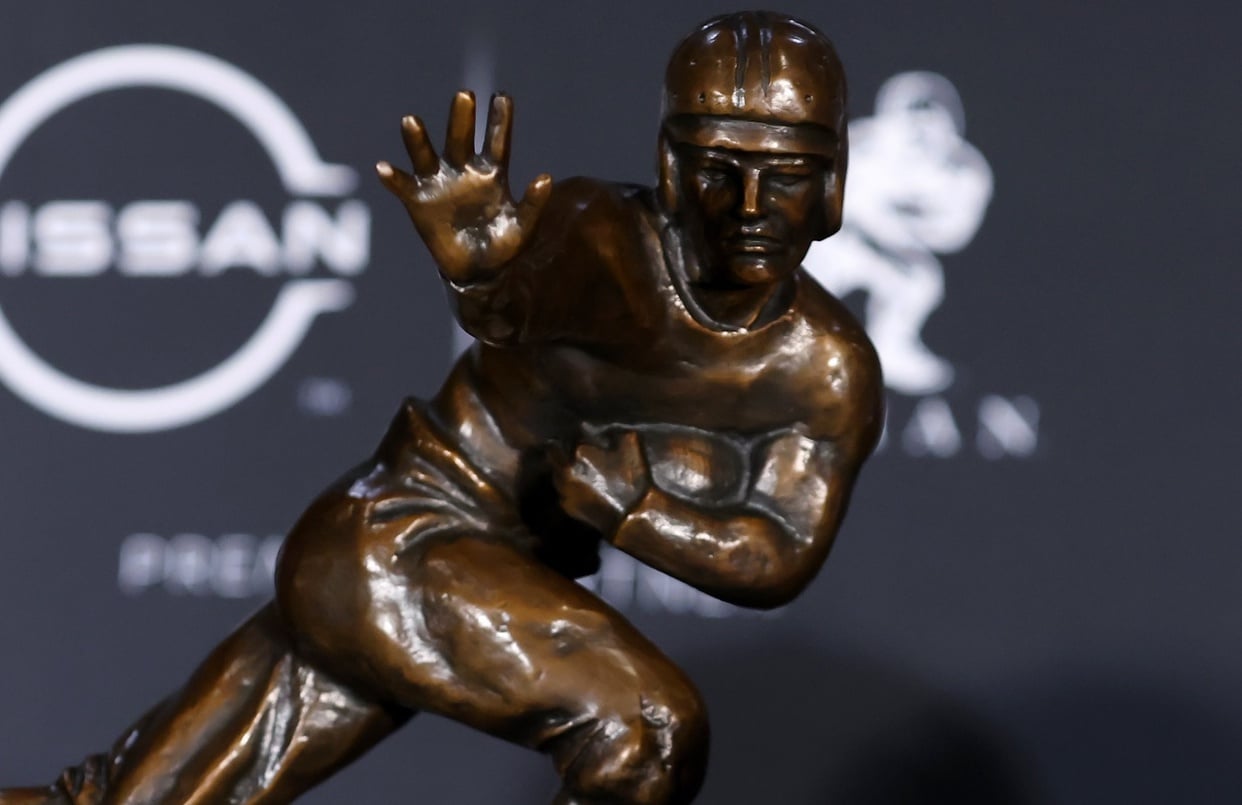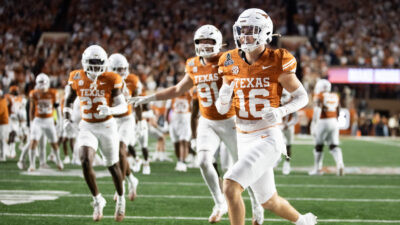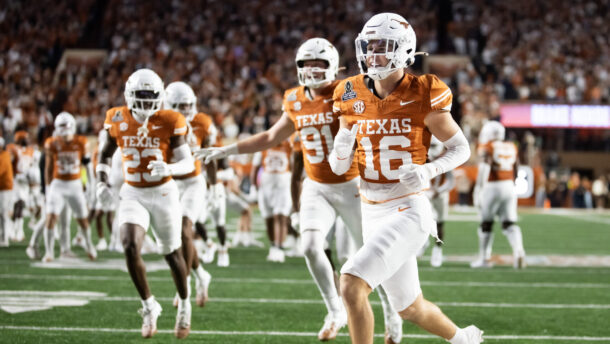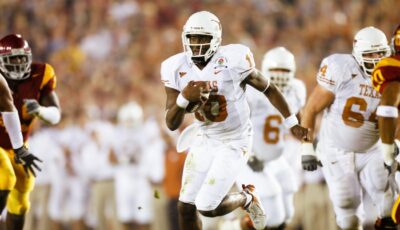
The lack of running backs in the recent Heisman races is even more significant than you realize
When Derrick Henry edged out Christian McCaffrey to win the 2015 Heisman Trophy, it felt like a narrative that had picked up steam was finally dead.
“It’s a quarterback award.”
That year, Henry, McCaffrey, Leonard Fournette, Dalvin Cook and Ezekiel Elliott accounted for 5 of the final 8 spots in the voting. More important, Henry’s victory marked the first time since 2009 that a running back won the award. At the time, it was fair to call it a “return of the back.”
Since then, though? We’ve had 7 Heisman Trophy ceremonies. Obviously, 0 running backs have won the award.
More alarming is the fact that Bryce Love (2017) was the only running back who was invited to New York in that 7-year stretch. Mind you, we’ve seen 2 defensive ends get invited to New York while 2 receivers were finalists, including DeVonta Smith, who won it in 2020. The 2017 season was the last time that a running back finished in the top 4 of the Heisman voting.
Is it just a drought? Or is it perhaps a sign that running backs are no longer being seriously considered to take home the honor as the nation’s top player?
It’s not as if there have been a dearth of elite running backs. Blake Corum, Bijan Robinson, Jonathan Taylor, Saquon Barkley, Najee Harris, Kenneth Walker III, Breece Hall, Travis Etienne, Chuba Hubbard, JK Dobbins … you could find plenty of recent stud backs who never got the opportunity to stand as a Heisman finalist. Taylor is the Big Ten’s No. 2 leading rusher in career yards and Etienne actually broke the ACC mark while also smoking the conference’s all-time scrimmage touchdowns record (he has a 22-touchdown lead on the leaderboard).
Sure, we’ve gotten away from the “career achievement” honor for Heisman candidates, but even if you break down the numbers, it’s clear that we hold running backs to a higher standard now than we did even in 2009 when Mark Ingram won the award.
| Pre-Heisman stats | 2009 Mark Ingram | 2017 Jonathan Taylor |
| Rushing yards | 1,542 | 1,847 |
| Rushing TDs | 15 | 13 |
| Scrimmage yards | 1,864 | 1,929 |
| Scrimmage yards/game | 143.4 | 148.4 |
One guy won the Heisman, the other didn’t even get a New York invite. Sure, it was a different era, but we’re only talking about 8 years difference here.
I realize that Ingram was on a 13-0 Alabama team (pre-Heisman), but let’s not forget that Taylor’s breakout came for a 12-1 Wisconsin team that nearly beat Ohio State in the Big Ten Championship.
What about Harris? He was part of an undefeated Alabama team in 2020. Smith’s record-breaking season at receiver was one for the ages, but isn’t it wild to think that Harris wasn’t even a finalist with numbers like this?
| Pre-Heisman stats | 2009 Mark Ingram | 2020 Najee Harris |
| Rushing yards/game | 118.6 | 114.7 |
| Rushing TDs/game | 1.15 | 2.18 |
| Scrimmage yards/game | 143.4 | 143.5 |
Yet even with numbers that were comparable — or even better — to Ingram, Harris was 3rd on his own team in the Heisman voting because of the gaudy passing numbers.
The 2016-22 running back drought could just be that simple. It’s not that running backs have regressed. I’d actually argue that running back play has progressed because of the diversity within modern schemes. It’s just that passing has progressed at a more significant rate.
That’s why it’ll take an outlier season for a running back to end the Heisman drought.
Henry had the outlier season. For all the talk about how McCaffrey was snubbed, we lose sight of the fact that Henry had an insane 1,986 rushing yards and 23 rushing scores pre-Heisman. From 2016-22, here are the leaders in single-season pre-Heisman rushing yards among Power 5 backs:
- 2016 D’Onta Foreman, Texas — 2,028 yards
- 2018 Jonathan Taylor, Wisconsin — 1,989 yards
- 2017 Bryce Love, Stanford — 1,973 yards
- 2019 Chuba Hubbard, Oklahoma State — 1,936
- 2019 Jonathan Taylor, Wisconsin — 1,909 yards
Also of note, Foreman finished 8th in the Heisman voting behind a defensive end (Jonathan Allen) and a defensive back/return specialist (Jabrill Peppers). Also also of note, Foreman did his damage for a 5-7 Texas team. If you can’t even reach the Liberty Bowl, you’re not winning the Heisman as a running back in the 21st century.
But Taylor’s inability to even reach New York suggests that in this current era, it’ll take a 2,000-yard rushing season (pre-Heisman) for a team that’s en route to the Playoff for a running back to even have a chance. Maybe that can be tweaked if we see someone with the do-it-all explosiveness of someone like 2015 McCaffrey, who probably would’ve won the award in years like 2022 and possibly even 2020.
But it might be unfair to assume that one of the household names at the position would move the needle. Like, if Corum has 1,600 pre-Heisman rushing yards for a Big Ten Champion Michigan, would that be enough to put him in the conversation? Probably not, despite the fact that that’s a phenomenal season.
Vegas is on to this, too. It’s Corum who has the best odds of any running back at 30-to-1. There are 14 quarterbacks with better odds than him, and Marvin Harrison Jr. is also at 30-to-1.
How about the fact that we just watched Quinshon Judkins have the most rushing yards of any SEC true freshman since Herschel Walker and going into his sophomore season, his Heisman odds are 65-to-1. And by the way, Judkins didn’t even crack the top 10 of the final Heisman voting for that prolific true freshman season.
It feels like if a running back is going to end the drought, it’ll have to be a season that catches everyone off guard. We knew that Henry and McCaffrey were exceptional players entering 2015, yet neither one was a preseason first-team selection. Perhaps that’s the path for a running back in today’s game.
Just don’t start off on everyone’s radar, rack up a 2,000-yard rushing season (pre-Heisman) and do so for a team with a legitimate national title path.
No sweat, right?
Connor O'Gara is the senior national columnist for Saturday Down South. He's a member of the Football Writers Association of America. After spending his entire life living in B1G country, he moved to the South in 2015.







